A look at Disneyland Records’ first dialogue-driven “Storyteller” recording, its three narrators, and its variations from 1958 to today.

Walt Disney’s Story of PETER PAN
Told by Jimmie Dodd
Disneyland Records – Storyteller Series ST-3910 (12” 33 1/3 RPM LP with Book / Mono)
Reissue: Magic Mirror Edition (1960)
Originally Released in May 1957. Producer/Editorial Supervisor: Tutti Camarata. Musical Director: Oliver Wallace. Vocal Arrangements: Jud Conlon. Based on the Play by James M. Barrie. Story: Ted Sears, Ed Penner, Bill Peet, Winston Hibler, Joe Rinaldi, Milt Banta, Ralph Wright, Bill Cottrell. Running Time: 28 minutes.
Cast: Bobby Driscoll (Peter Pan); Kathryn Beaumont (Wendy); Hans Conreid (Captain Hook, Mr. Darling); Bill Thompson (Smee, Pirates); Heather Angel (Mrs. Darling); Candy Candido (Chief); June Foray (Squaw); Paul Collins (John); Tommy Luske (Michael); The Jud Conlon Chorus, The Bob Mitchell Choirboys.
Songs: “The Second Star to the Right”, “You Can Fly! You Can Fly! You Can Fly!”, “What Made the Red Man Red”, “Your Mother and Mine”, “The Elegant Captain Hook” by Sammy Fain, Sammy Cahn; “A Pirate’s Life” by Ed Penner, Oliver Wallace; “Following the Leader” by Winston Hibler, Ted Sears, Oliver Wallace.
Instrumentals: “Peter Pan Theme” by Oliver Wallace; “Never Smile at a Crocodile” by Frank Churchill.
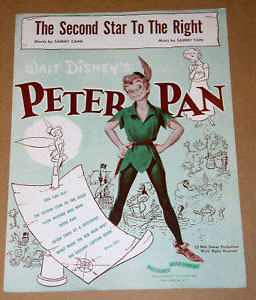 You can’t keep a good Pan down. Sir James M. Barrie’s play has been adapted countless times on stage, in silent film, animation, movies and television and continues to inspire new interpretations. The 1953 Walt Disney version is a streaming feature of the Disney+ service as well as one of the most popular theme park attractions ever created, a marvel of simplicity with queues rivaling the most elaborate “’E’ tickets” that regularly pop up to challenge it. Even Ray Bradbury was a fan of the ride, for which Florida’s Walt Disney World even created an elaborate walk-through “pre-show” queue that makes the wait time more entertaining and also lengthens the total experience.
You can’t keep a good Pan down. Sir James M. Barrie’s play has been adapted countless times on stage, in silent film, animation, movies and television and continues to inspire new interpretations. The 1953 Walt Disney version is a streaming feature of the Disney+ service as well as one of the most popular theme park attractions ever created, a marvel of simplicity with queues rivaling the most elaborate “’E’ tickets” that regularly pop up to challenge it. Even Ray Bradbury was a fan of the ride, for which Florida’s Walt Disney World even created an elaborate walk-through “pre-show” queue that makes the wait time more entertaining and also lengthens the total experience.
It’s worth pointing out that countless children in need also continue to benefit from Disney’s Peter Pan and other versions honoring Barrie’s granting of the copyrights to the Great Ormond Street Hospital. If we feel so moved, we can also contribute to this hospital, at no extra charge, through the Amazon Smile program.
Chronologically, the first soundtrack album released for Walt Disney’s Peter Pan was not the usual music and song presentation. That did not happen until 1960. First, Disneyland Records released Walt Disney’s Story of Peter Pan as a book and LP record set in 1958.
Narrated by grownup Mickey Mouse Club Mouseketeer/host Jimmie Dodd, this was the first time Disneyland Records produced an animated film soundtrack album using actual dialogue as well as music and songs. Previous albums presented only narration that bridged the songs and music (any dialogue was incidental).
 Peter Pan was only the second Disney home audio recording to use this dialogue format, the first being RCA’s Bambi told by Shirley Temple, but even that was a combination of soundtrack dialogue with background music and songs created for RCA. (More on that album and Shirley’s Dumbo recording in this Animation Spin.) From that point until the late seventies/early eighties, some Disneyland Records offered stories with soundtrack dialogue (Pollyanna, The Jungle Book, Robin Hood , Escape to Witch Mountain); studio reenactments based on the scripts (101 Dalmatians, Lady and the Tramp, 20,000 Leagues Under the Sea, The Aristocats); or a single narrator with music (Mary Poppins, Bedknobs and Broomsticks, Snow White and the Seven Dwarfs, Pinocchio). Occasionally an album would have a little of both studio actors and soundtrack elements, like Darby O’Gill and the Little People.
Peter Pan was only the second Disney home audio recording to use this dialogue format, the first being RCA’s Bambi told by Shirley Temple, but even that was a combination of soundtrack dialogue with background music and songs created for RCA. (More on that album and Shirley’s Dumbo recording in this Animation Spin.) From that point until the late seventies/early eighties, some Disneyland Records offered stories with soundtrack dialogue (Pollyanna, The Jungle Book, Robin Hood , Escape to Witch Mountain); studio reenactments based on the scripts (101 Dalmatians, Lady and the Tramp, 20,000 Leagues Under the Sea, The Aristocats); or a single narrator with music (Mary Poppins, Bedknobs and Broomsticks, Snow White and the Seven Dwarfs, Pinocchio). Occasionally an album would have a little of both studio actors and soundtrack elements, like Darby O’Gill and the Little People.
The 1958 Peter Pan Storyteller was produced while the Mickey Mouse Club was still a hit and the Mouseketeers were making appearances at Disneyland. Disney Legend Jimmie Dodd, Annette and Darlene were all narrators on various albums. Dodd’s complete sincerity and warmth shine through on all his recordings. In the case of Pan, he seems genuinely enthused and committed to the story’s heightened reality. As he was on television, Jimmie Dodd focuses directly on the individual listener.

Walt Disney’s Story of PETER PAN
Narrated by Ginny Tyler as the Disneyland Storyteller
Disneyland Records – Storyteller Series ST-3910 (12” 33 1/3 RPM LP with Book / Mono)
Released in 1962 (Magic Mirror), reissued in 1969. Producer/Editorial Supervisor: Tutti Camarata. Musical Director: Oliver Wallace. Vocal Arrangements: Jud Conlon. Based on the Play by James M. Barrie. Story: Ted Sears, Ed Penner, Bill Peet, Winston Hibler, Joe Rinaldi, Milt Banta, Ralph Wright, Bill Cottrell. Running Time: 28 minutes.
This is where it gets confusing. In 1960, several concurrent circumstances made it necessary for Disneyland Records to change the look and contents of its Storyteller series. The record company had done well once it focused the musical soundtracks on children and found ways to manufacture and distribute them more effectively. It’s always a good idea to freshen a product line, and in the case of the Storytellers, giving them a uniform look made them attractive as a set for direct mail sales.
The Magic Mirror series reflects all these decisions and more. The Mickey Mouse Club had left the ABC network, so the Mouseketeers, while still familiar to many, were not as prominent, so their names, while appearing on the early Magic Mirrors, were not on the front covers. According to veteran Disney record collector Daniel Evans Smith, the first editions in the Magic Mirror series still contained Mouseketeer records. The die-cut “mirrors” had actual clear vinyl windows and the interior pages were half-sized so the large painting seen through the mirror could be visible from the beginning to the end of listening or reading.
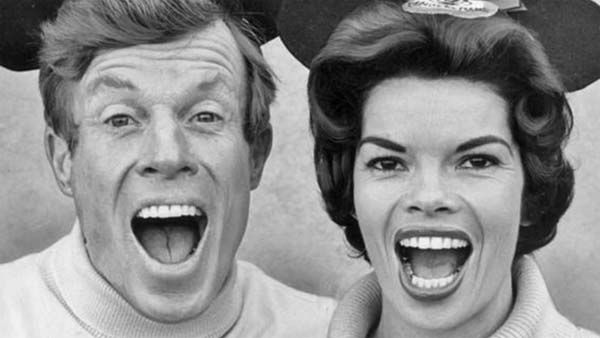
Jimmie Dodd and Ginny Tyler
In 1962, the Mickey Mouse Club was edited into half hours and syndicated to local stations. Select locations were fortunate to see new segments hosted by Disney Legend Ginny Tyler (a Disneyland Records regular who was also the voice of the Girl Squirrel in The Sword in the Stone and Jan on Space Ghost). At some point, and this is where it gets vague, the pages became full-sized and the painting was moved to the front so it could be seen through the mirror.
 Ginny recorded from the same script as Jimmie Dodd but gave a different but no less superb performance, in fact among her very best in the Magic Mirror series. When the cannonball is coming toward Peter and the children, there is urgency in her voice. At the conclusion, the sense of gentle calm is evident as Mr. Darling looks at the ship in the distance. It’s no wonder that Walt Disney himself told her, “You are my Disneyland Storyteller” one day as they were walking through Disneyland.
Ginny recorded from the same script as Jimmie Dodd but gave a different but no less superb performance, in fact among her very best in the Magic Mirror series. When the cannonball is coming toward Peter and the children, there is urgency in her voice. At the conclusion, the sense of gentle calm is evident as Mr. Darling looks at the ship in the distance. It’s no wonder that Walt Disney himself told her, “You are my Disneyland Storyteller” one day as they were walking through Disneyland.
Like the other “Tyler-ized” Magic Mirror Storytellers, the music and other track materials were abruptly cut rather than smoothly faded under the narration. This has to be an economic issue. To save time and money, the finished mixes of the earlier versions were simply cut rather than obtaining all the tracks again and slipping them in and out. Hours and dollars were saved while the record company steadied its course. It wasn’t always successful artistically, but in the case of Peter Pan, it was not as obtrusive.
In 1969, the Magic Mirrors were discontinued and full covers were created for the Storytellers. The record inside was usually the Ginny Tyler version, but it was very possible to find an earlier edition inside and there was no way of knowing from looking on the cover. Occasionally, one side would have Ginny and the other side would the previous narrator. This continued throughout the seventies.
Before there was home video, one had to wait years to see Peter Pan in theaters. This was one of the very few early Disney albums that allowed the home audience to visit an animated feature in a more thorough and detailed way anytime. It was a precious privilege.
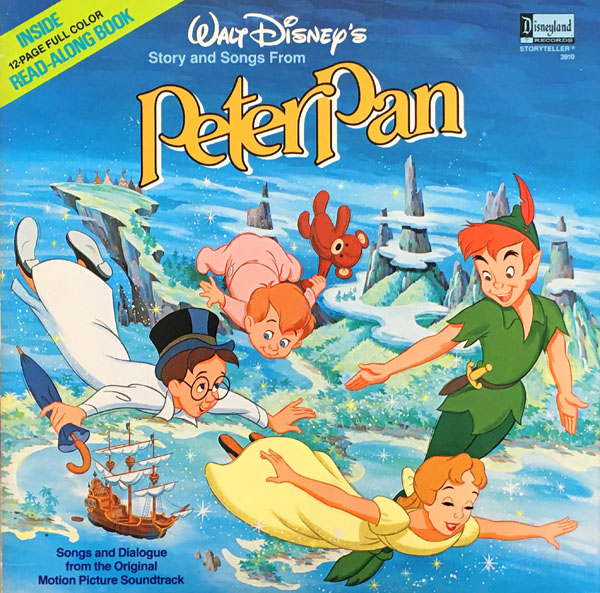
Walt Disney’s Story of PETER PAN
Narrated by Laurie Main
Disneyland Records – Storyteller Series ST-3910 (12” 33 1/3 RPM LP with Book / Mono)
Reissues: Picture Disc #3110 (1982); Audio Cassette #60962-4 (1989)
Currently available for Download on iTunes and other Streaming Services
Originally Released in 1982. Producer/Editorial Supervisor: Ted Kryczko. Narration Written by Jymn Magon. Musical Director: Oliver Wallace. Vocal Arrangements: Jud Conlon. Based on the Play by James M. Barrie. Story: Ted Sears, Ed Penner, Bill Peet, Winston Hibler, Joe Rinaldi, Milt Banta, Ralph Wright, Bill Cottrell. Running Time: 33 minutes.
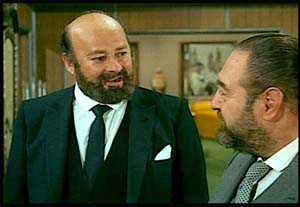
Laurie Main and Sebastian Cabot in “Family Affair”
Laurie Main adds a British flavor (though he was born in Australia) to this version of the Storyteller. Main developed a latter-day “Sebastian Cabot” career with Disney, both on records, in animation and on-camera (Disney Channel’s Welcome to Pooh Corner), as he had a voice and manner similar to Disney’s first Pooh narrator. Main also appeared on three episodes of Cabot’s popular CBS series Family Affair as well as dozens of other series and films.
The 1982 album so tightly edited, it is virtually devoid of anything non-visual with ample narration to cover what is not seen. The edits are smoothly cross-faded to compress the scenes without making them seem rushed. There is a noticeable difference in the pacing of the high-energy scenes and the more moderate ones, a combination of the film’s artful cutting and the audio editing in the absence of the images.
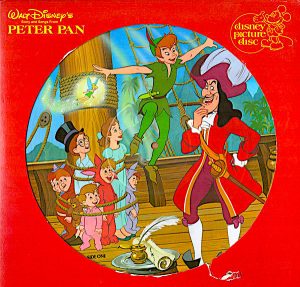 Producer Ted Kryczko recalled the making of the album. “The Peter Pan 1982 Storyteller was my first full project at Disney,” he told me. “I started on a Monday and this was on my desk by noon on Tuesday. I produced it and (as it was a very small team then) also laid out the images and copy in the booklet.” (Depending on the version, some editions were read-alongs and some had photo folios with text.)
Producer Ted Kryczko recalled the making of the album. “The Peter Pan 1982 Storyteller was my first full project at Disney,” he told me. “I started on a Monday and this was on my desk by noon on Tuesday. I produced it and (as it was a very small team then) also laid out the images and copy in the booklet.” (Depending on the version, some editions were read-alongs and some had photo folios with text.)
One song is conspicuously absent on the first edition of the book-and-LP set. “You Can Fly! You Can Fly! You Can Fly!” is not heard until the end of the album. The nursery sequence does not contain the song at all. Something must have happened along the way to change that, however. On the picture disc, cassette and download versions, the song was restored.
“At the time, the leadership was very cost-conscious and directed in great detail how long a recording could be and how much music (royalties) could be used. I’d guess that was a likely reason. Being the new guy I simply had to find a way. Hence you are probably correct about the nursery sequence you reference. Later as the label was growing more successful and leadership eased things could be ‘fixed’. Honestly, I don’t remember if there were requests to change it but I wouldn’t doubt it. So when a new version was to release, that’s when the cost bosses would see fit to do so. I adored the picture disc series.”
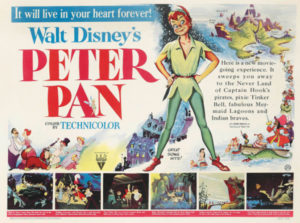 Another remarkable thing about this album is the way it sounds as if Ted had a number of isolated music tracks from the film available for the background. But this was long before Randy Thornton restored the soundtrack and all the music. Ted combed through the finished film track and found instrumental moments where there were no sound effects or dialogue, then he placed them over other dialogue to make them sound as if they belonged there. He did this with quarter-inch tape, not digitally. Magnetic tape was edited by hand on a little metal block with a one-sided razor blade and joined with splicing tape.
Another remarkable thing about this album is the way it sounds as if Ted had a number of isolated music tracks from the film available for the background. But this was long before Randy Thornton restored the soundtrack and all the music. Ted combed through the finished film track and found instrumental moments where there were no sound effects or dialogue, then he placed them over other dialogue to make them sound as if they belonged there. He did this with quarter-inch tape, not digitally. Magnetic tape was edited by hand on a little metal block with a one-sided razor blade and joined with splicing tape.
“Mostly just me and my trusty razor blades, following a script Jymn Magon had prepared.”
And the Storyteller still available to this day, complete with “You Can Fly!”
Ginny Tyler as “The Disneyland Storyteller”
This video shows an example of a Magic Mirror album with Ginny Tyler is on the recording. Sometimes the inside cover would be copyrighted 1962 even though the front cover was copyrighted 1960. Even the back covers varied. One could never be completely sure whether it was Dodd or Tyler after 1962. If it had a plastic window, chances are it was a 1960 Jimmie Dodd version.


 GREG EHRBAR is a freelance writer/producer for television, advertising, books, theme parks and stage. Greg has worked on content for such studios as Disney, Warner and Universal, with some of Hollywood’s biggest stars. His numerous books include Mouse Tracks: The Story of Walt Disney Records (with Tim Hollis). Visit
GREG EHRBAR is a freelance writer/producer for television, advertising, books, theme parks and stage. Greg has worked on content for such studios as Disney, Warner and Universal, with some of Hollywood’s biggest stars. His numerous books include Mouse Tracks: The Story of Walt Disney Records (with Tim Hollis). Visit 





















































Thanks for this comprehensive look at the Storyteller version of Peter Pan as it developed over the years. The story of Disneyland Records/Walt Disney Records is inherent in the examination of the evolution of one of the titles like this. It is immediately impressive, especially on comparison with the other titles in the series, that so much dialogue from the film is employed. (Strikes me as a bit odd that the shooting of the singing pirate by Captain Hook is included on an album that is primarily intended for children! I guess it was to show how bad Captain Hook really was!)
The Magic Mirror editions are a fascinating study. Last year I was able, through much extensive internet searching, to find reasonable reproductions of the “surprise pictures” (my name for them) displayed in the Magic Mirror reveal. It is interesting to note what was visible through the window and what was not. For example, Wendy is positioned immediately to the right of Tinker Bell and John is poised with his umbrella in a fencing stance just beyond Captain Hook’s left shoulder.
The sixties and early seventies were certainly a busy time for Ginny Tyler. Her work for Disneyland Records as well as for Hanna-Barbera and others was extensive to say the least. Also she provided the voice of Pinocchio for Disney on Parade and was interviewed on television regarding this performance. She talked about her “boy voice” and was pleased to be considered convincing enough to be hired for such roles.
This is the first I knew about Laurie Main’s narration for the later Peter Pan album. I had previously assumed that the later reissue was done with Ginny Tyler’s recording. It is very interesting that as late as 1982 there were still revisions being made to the records–just before vinyl was about to disappear (temporarily as it turned out). I will definitely keep an eye (and an ear) out for Main’s recording.
Ah yes, this takes me back to the days of analog recording on magnetic tape. I remember rolling the tape manually back and forth over the playback head until I found just the right spot, then placing it in that little metal box with the quarter-inch groove for the tape and the little diagonal one for the razor blade, and getting little scraps of splicing tape stuck all over my clothes and in my hair. All of this has about as much relevance to the modern recording industry as Edison yelling into a funnel. To hear us talk, studio engineers who grew up with digital systems must think we used to record music on long strips of tree bark that we spliced together using flint hand-axes and beeswax when we weren’t hunting mastodons or inventing fire. Even we boys who never grew up, and still watch cartoons every day, can’t avoid getting old.
Hmmm. I must have had the 1962 version of the album. I can’t find it in the collection of LP’s that I was able to save. What I remember most about it was the song, “Never Smile With a Crocodile,” which I really enjoyed, but the song was apparently cut from the final film! I believe I got the record album before I saw the animated film. We had seen the Mary Martin play version on TV. Back then, I never could understand why I was slightly attracted to “Peter Pan,” because as a kid, I never would have believed a woman would play a young boy! Those were the days!
In the end, “Never Smile at a Crocodile” ended up as an underscore for the croc’s appearance in the movie.
Yes! I wasn’t even born yet when the film came out – but with Disney’s policy for re-releasing films every seven years, I THINK I saw it in the early ’60s as a wee youngster, I’m not sure, but I do remember the highly touted Mary Martin stage version re-release on TV when I was a kid. Somehow, for one reason or another, I got that early ’60s album, at any rate. I remember that years later – maybe when PETER PAN was released on VHS, I recalled that the music for the song DID remain in the film. I loved that song and wished it had made the final cut of the movie!
As a kid I had (and probably still do someplace) a Disney 33 with the Peter Pan story with narration+dialog on one side of the disk and the Alice in Wonderland film story on the other side. I’m sure it was purchased in the late ’50s, but I don’t see the cover art here. I listened to it countless times as a child, memorizing inappropriate songs like “What Made the Red Man Red”. I never actually saw the film until adulthood, which I kind of like. Listening to an auditory story like that is great stimulation to the young visual imagination.
The “Peter Pan / Alice in Wonderland” LP was released by RCA Victor (later RCA Camden): both were originally on 2 7″ 45’s with a read-along illustrated storybook by the same label. The compiled LP featured an impressive artwork by Pete Hawley (Peter Pan flying in circles around Captain Hook with the crocodile approaching the beach).